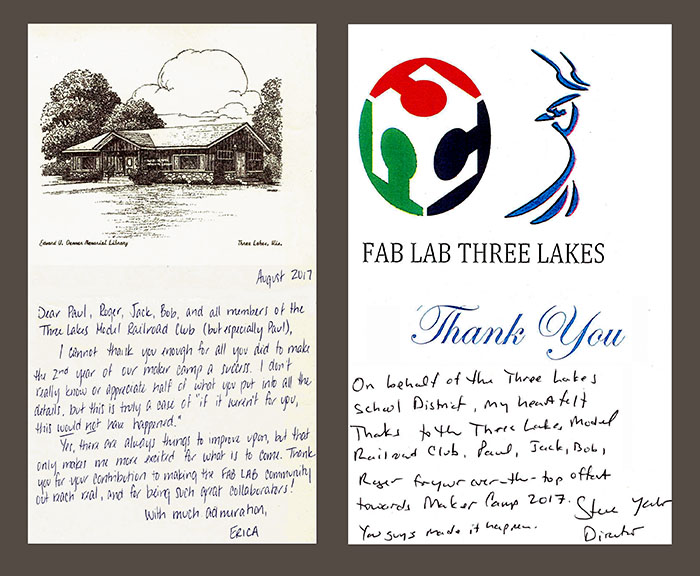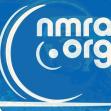STEAM and Model Railroading at the
Three Lakes Model Railroad Club.
Science, Engineering, Technology and Math, (plus Art) = “STEAM”
TLMRC Support of the Three Lakes Make It! Camp reported on NBC "Newswatch 12 Today"
To see the newscast (Click Here)
The 2019 Make It! Camp (Our fourth year) was a success, photos and links to come. Survey says 90% would return and 80% would bring a friend next year.
November 2018 meeting generates new programming for teaching signal operations.
Each year in the summer the Three Lakes Model Railroad Club (a 100% NMRA Club) partners with the Demmer Memorial Library, Three Lakes, WI, to present a Make It! Camp for young people of middle and high school age held at the Fab Lab Three Lakes.
The Club provides its modular HO layout which is DCC and contains microcontroller-based tri colored signals. The layout has 7 blocks detected by NCE BD-20 and 10 Signals each with 3 colored LEDs. Along with the layout we provide breadboards and other components for learning about electricity. We also supply modules with local historic locations that contributed to the development of the area around Three Lakes, WI. Students are given the opportunity to build workers’ housing for the Starks Potato Farms by selecting walls for the sides and ends and cutting them out of Evergreen plastic on a laser while 3D printing the windows and doors. They then assemble the structures and add them to the potato farm on the layout around the Starks Certified Seed Potato Warehouse. For railroad support they may choose to use the same tools to build a section house that they may place along the main line. (See progress on the Module construction Click Here)
AC, DC, and DCC (Sq. Wave AC Data) is covered in the operation of the layout and the operation of LED signals. The students learn about block signals and first develop the logic (Truth Table) for a set of Automatic Block Signals (ABS) protecting a single-track main line in one direction. They then create a program for an Arduino microcontroller to operate the signals testing them on the modular layout. With the success of this task we give the students the challenge of operating the layout with bidirectional signals on the modules having both single and double track on the main line. The modules have 7 blocks and 10 signals thus 7 inputs and 30 outputs to program. The students use serial and parallel connections for data transfer to control the signals. After groups of students work on their logic and program, they then bring a flash drive with their program to the modular layout to test the operation. Club members are available to help with the logic design, programming, and debugging the results on the layout. A breadboard example of a 4 block 4 signal operation and associated program is available for the testing of logic. This seemingly simple operation exposes the students to the many areas of electricity with the use of AC and DC current, resistors, transformers, diodes, all connecting between a model railroad and a microcomputer. DCC examples allow a demonstration of programming locomotives for operation, lights and sound via a USB connection and JMRI DecoderPro on a laptop computer.
All this technology provides the students with the opportunity to learn the science behind the technology while using engineering principals to develop and test their projects. Construction of structures adds art and design using 3D printers and lasers which are introduced by having the students create individual keyrings on the laser by etching and cutting plastic. 3D printing of windows and doors as well as their own objects of art allow students to be creative. Books on the history of areas depicted on the modules provide additional information about the development of the North Woods.
As we have expanded our time with the students, we have added robotics to the activities. The model railroad club members have extended their use of the microcontrollers from controlling trains to controlling robots via Infrared (IR) signals that allow them to tell the robotic vacuum cleaners where to move, when to stop, and which way to turn to follow paths taped to the floor in the hall of the school. We get to give the students a little additional math by having them measure and calculate how long to move their robot in a direction before tuning in order to stay on the paths. In this activity we also encourage the students to wire their own bread boards and add LEDs that tell them what the program has instructed the IR LED to send to the robot. This is a hands-on project that allows the students to wire power and data lines to control and report the actions of their programs. Breadboards, wires, resistors, many color LEDs and IR circuit boards all are combined to make a vacuum cleaner go where they tell it to go.
While the Camp is held on weekdays, with lunch included, the Fab Lab has open house Tuesday and Thursday evenings where parents and siblings may come and see what the students are working on and maybe even watch them create additional items of their own design. We are also lucky that the local NBC station CH12 Rhinelander comes out and does a report on the camp each year. Having the trains as a tease for viewers of the news broadcast as well as an introduction to the coverage puts model railroads in every home that is watching the news at 6:00, 10:00 or during the Today Show local updates.
A camp like this could not exist without the direction of director and staff of the library and the director of the Fab Lab Three Lakes, along with the members of the Three Lakes Model Railroad Club all worked a good part of the year to plan and prepare for the Camp. We also salute our students who could be outside playing on our chain of lakes on these warm summer days and of course their parents who bring support and transport them to the Three Lakes School for the Camp.
The Three Lakes Railroad Club also supplies trained BSA Merit Badge and Nova councilors for Electricity, Radio, Electronics, Railroads, Robotics and more.
Topics exposed to the students:
Electricity
Alternating Current, Sign Wave and Square Wave
Transformers and rectifiers
Direct Current
Voltage and Current
Resistance to current flow
Diodes allowing current to flow in only one direction
Light Emitting Diodes (LEDs) that will light when limited current flows in only one direction
Motors converting electrical current into mechanical movement
Data
Bits, Bytes, 1s and 0s
Serial and parallel data sent by wire, light, and electromagnetic waves
Logic of Truth Tables
Logic operators like And, Or, Exclusive Or, Not
Machine control
Programing a laser to etch and to cut
Programming 3D Printers to print the scale of an object
Programming Microcomputers and Microcontrollers
Railroad Operations and Safety
Dispatching
Signals and their use
Crossing safety (Operation Lifesaver)
Digital Command Control programming of lights and sounds
Having fun with model trains




View the Make It! Camp report (Click here)
